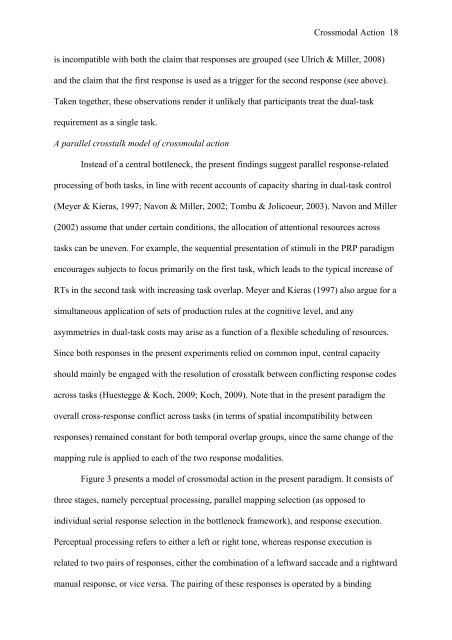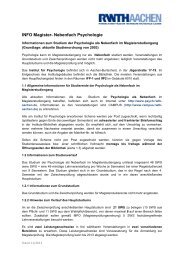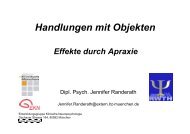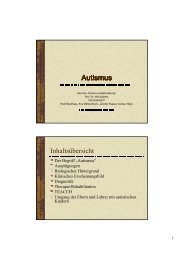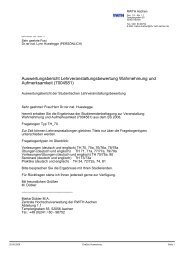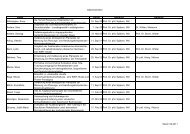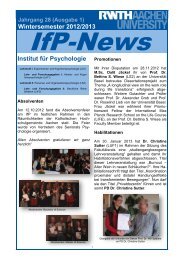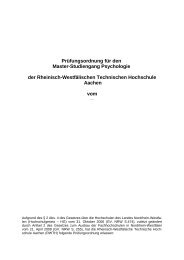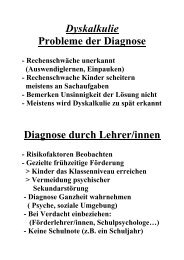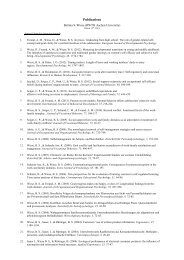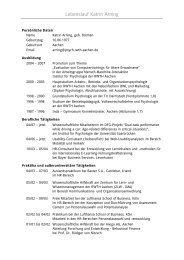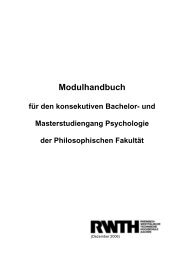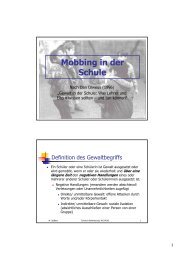Crossmodal Action 1 Crossmodal Action Selection - RWTH Aachen ...
Crossmodal Action 1 Crossmodal Action Selection - RWTH Aachen ...
Crossmodal Action 1 Crossmodal Action Selection - RWTH Aachen ...
You also want an ePaper? Increase the reach of your titles
YUMPU automatically turns print PDFs into web optimized ePapers that Google loves.
<strong>Crossmodal</strong> <strong>Action</strong> 18<br />
is incompatible with both the claim that responses are grouped (see Ulrich & Miller, 2008)<br />
and the claim that the first response is used as a trigger for the second response (see above).<br />
Taken together, these observations render it unlikely that participants treat the dual-task<br />
requirement as a single task.<br />
A parallel crosstalk model of crossmodal action<br />
Instead of a central bottleneck, the present findings suggest parallel response-related<br />
processing of both tasks, in line with recent accounts of capacity sharing in dual-task control<br />
(Meyer & Kieras, 1997; Navon & Miller, 2002; Tombu & Jolicoeur, 2003). Navon and Miller<br />
(2002) assume that under certain conditions, the allocation of attentional resources across<br />
tasks can be uneven. For example, the sequential presentation of stimuli in the PRP paradigm<br />
encourages subjects to focus primarily on the first task, which leads to the typical increase of<br />
RTs in the second task with increasing task overlap. Meyer and Kieras (1997) also argue for a<br />
simultaneous application of sets of production rules at the cognitive level, and any<br />
asymmetries in dual-task costs may arise as a function of a flexible scheduling of resources.<br />
Since both responses in the present experiments relied on common input, central capacity<br />
should mainly be engaged with the resolution of crosstalk between conflicting response codes<br />
across tasks (Huestegge & Koch, 2009; Koch, 2009). Note that in the present paradigm the<br />
overall cross-response conflict across tasks (in terms of spatial incompatibility between<br />
responses) remained constant for both temporal overlap groups, since the same change of the<br />
mapping rule is applied to each of the two response modalities.<br />
Figure 3 presents a model of crossmodal action in the present paradigm. It consists of<br />
three stages, namely perceptual processing, parallel mapping selection (as opposed to<br />
individual serial response selection in the bottleneck framework), and response execution.<br />
Perceptual processing refers to either a left or right tone, whereas response execution is<br />
related to two pairs of responses, either the combination of a leftward saccade and a rightward<br />
manual response, or vice versa. The pairing of these responses is operated by a binding


